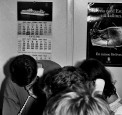MS Estonia Catastrophe
The Estonia disaster occurred on Wednesday, 28 September 1994, between about 00:55 to 02:03 (UTC+2) as the ship was crossing the Baltic Sea, en route from Tallinn to Stockholm. She was carrying 989 people: 803 passengers and 186 crew members. 137 people managed to survive in the catastrophe, 852 died. The dead bodies of only 95 drowned people were found.
The ship disappeared from the radar screens of other ships at around 01:50, and sank at 59°23′N 21°42′E / 59.383°N 21.7°E / 59.383; 21.7, about 22 nautical miles (41 km; 25 mi) on bearing 157° from Utö island, Finland, in 74 to 85 metres (243 to 279 ft) of water.
The visor was ’officially’ found 1,560 metres west of the wreck on 18 October 1994 at 70 metres depth and was salvaged in the middle of November 1994 to investigate the cause of the catastrophe. It was taken to Hanko, Finland. In 1999 the commission of inquiry gave the visor to the Swedish Maritime Museum and it was taken to the port of Södertälje. From there it was in 2002 moved to the Swedish naval base on the island of Muskö.
There are a few conspiracy theories, involving secret transportation of military equipment, bomb explosions on board, leaks in the hull, etc. that try to explain the disaster. The official report of the international commission indicated that the locks on the bow door had failed from the strain of the waves and the door had separated from the rest of the vessel, pulling ajar the ramp behind it. The subsequent failure of the bow ramp allowed water into the vehicle deck, which was listed as the main cause of the capsizing and sinking.
To commemorate those who died, several monuments have been erected in Estonia - near the tower of Paks Margareeta in Tallinn, on Tahkuna peninsula on the island of Hiiumaa, in Pärnu, in Võru near Katariina Church, and also in Stockholm.
The thing that the exact facts of the catastrophe are still not clear and the commission has failed to convince the public about its findings, makes people still interested in what actually happened.
The ship's sinking in the Baltic Sea on 28 September 1994 claimed 852 lives and was one of the worst maritime disasters of the 20th century. In terms of lives lost, it is the single deadliest shipwreck disaster in peacetime to have occurred in the Baltic Sea in recorded history.
 M/S Estonia Munsterroll - Crewlist
M/S Estonia Munsterroll - Crewlist
m/s Estonia © TV4











